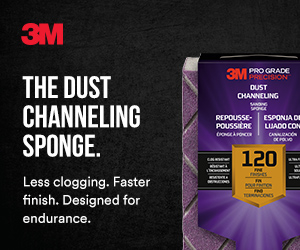 Kannan Seshadri, Ph.D., is an advanced product development specialist for 3M. He has extensive experience with the development of products, including abrasives, and also holds patents and has published scientific articles related to coatings and abrasives. Here, Seshadri answers a question about how to work with sanding sponges.
Kannan Seshadri, Ph.D., is an advanced product development specialist for 3M. He has extensive experience with the development of products, including abrasives, and also holds patents and has published scientific articles related to coatings and abrasives. Here, Seshadri answers a question about how to work with sanding sponges.
Q: I’m using a sanding sponge on drywall for the first time, instead of sandpaper. How do I get the most out of this tool?
A: A sanding sponge is a more ergonomically friendly tool than sandpaper alone or even when used with a sanding block. When using a sanding block, you grip the sides of the sponge with your fingers, allowing the abrasive to do the work instead of needing to push down with the palm of the hand on the block. Sanding sponges also offer flexibility, which allows for the abrasive to more fluidly move along the contours of a curved surface. You can make the most of these benefits with proper technique and a solid understanding of the drywall surface you’re working with.
When sanding drywall, you’re likely dealing with two scenarios: a seam on a new wall or a patched hole on an existing wall. The condition of the wall and joint compound will play a large role in the successful use of the sanding sponge.
A progressive approach to grit ratings
It’s important to start with the right sanding sponge grit. For rougher surfaces, I recommend a 60-grit sponge. If the drywall professional did a great job with the seam and it appears smooth to start with, you might be able to use an 80-grit sponge. Do not start with a very fine grit. You’ll end up applying too much force and the caking will ruin the sponge, then you may end up harming the surface.
Corners can sometimes have heavy buildup of joint compound. It’s almost impossible to fold sandpaper at the correct angle to get into rough corners. That’s why a sanding sponge is ideal for corners; it helps to effectively sand the surface all around as well as those hard-to-reach corners. Consider using 45˚- or 60˚-angle-edge sponges for these areas.
When starting with a coarse grit, you’ll want to apply very light pressure at first. Being too aggressive could create scratches that show through the final paint coat. Then, it’s important to move through each grade of grit to the finest grit. Do not skip grits. For drywall, a 150-grit sponge is usually the finest grit needed. I also recommend shining a light on all jobs to give a clear and accurate view of your work as you progress through the grit levels.
Channeling technology benefits
Sanding sponges with channeling technology can also help improve your work. Channels allow for the easy removal of dust particles—and reduce the likelihood of them caking on the abrasive surface. You can sand for longer periods with these tools, and all it takes is a couple light taps to easily release any extra build-up of particles on the abrasive’s surface.
Channels also minimize airborne dust, a potential job safety hazard. The one caveat with using sponges with channels, however, is to make sure you are not overly aggressive on rough surfaces. This can contribute to a patchy look.
Other considerations
A common scenario painting professionals encounter is a homeowner’s patched hole on a wall. Often, you need to take into consideration the patch material and the finish/sheen around the hole. In these cases, when you use the sponge, start with a coarse grit, but you’ll also need to feather past the area where the patch compound ends and the old paint starts.; you don’t want sheen differences or lines where they meet.
When dealing with these situations, you’ll want to check the sponge regularly. If the paint is a water-based acrylic, you’re less likely to encounter a problem. But if the coating is an older, heavy, solvent-based one, the abrasive may fail early due to gumming of coating material onto the abrasive. In these cases, you may need to budget more into your estimate for additional sanding sponges.
More pros are turning to sanding sponges for drywall sanding due to the ergonomic benefits and ease of use. But, to fully realize the sponge benefits, it’s important to be aware of the surface condition and to utilize proper techniques as well.




